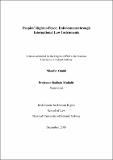| dc.description.abstract | This study presents a bottom-up approach to address the current impasse regarding the international peace. It notes that the existing top-down remedies for peace presented by leaders who are involved in committing crimes against peace have not been productive. Hence, this research hypothesises a solution that rests on empowering nations as right holders through a focus on an undeveloped post-Cold War right, namely the right of peoples to peace. This project adopts a combination of methods from inter-disciplinary contexts, including conceptual framework analysis, legal doctrinal analysis, and reflective equilibrium method. It employs a cosmopolitan methodology; however, it considers other philosophical theories, such as utilitarianism, in order to prohibit unconscious dogmatism.
At the outset, the research advances a methodology to establish such a “right”. It provides a conceptual-legal framework for the “right to peace” by focusing on the normative content of entitlement, right holders and duty bearers through an international legal lens. Then, it lays a philosophical groundwork for this right to justify it. The study explores and develops a mechanism through which the right to peace can be implemented. For this purpose, political violence from above - specifically aggression - among various categories of violence is a point of focus. It discusses the prosecution of the crime of aggression as the implementation mechanism of this right, and analyses the existing deficiencies in international criminal law instruments. It analyses the “Kampala amendments” to the Rome Statute in order to explore the loopholes relating to the implementation of this right. It addresses the institutional mechanisms of the accountability of the UN Security Council, as one of the duty-bearers of the right to peace. In other words, the research endeavours to end the politicisation of the formula for peace through the judicialisation of it. This new formula may lead to engagement with other contemporary policies which result in the violation of peace, such as internal conflicts, state-executed terrorist attacks and proxy wars, with the aim of achieving Goal 16 of the 2030 Agenda for Sustainable Development concerning peace, justice and strong institutions. | en_IE |


